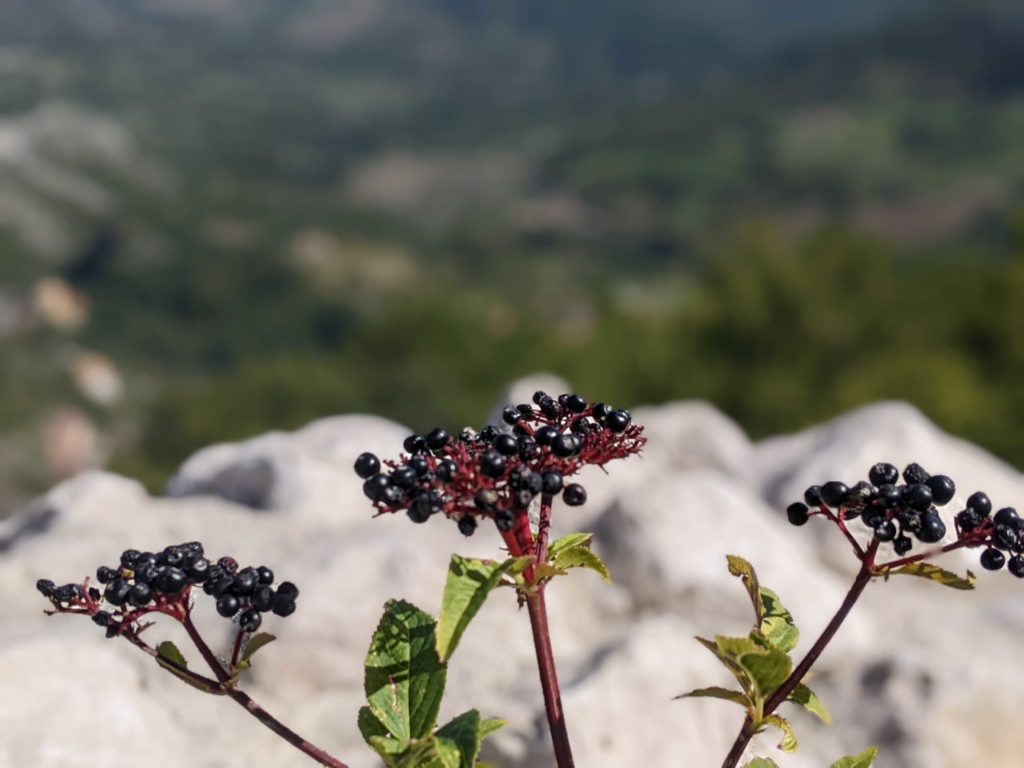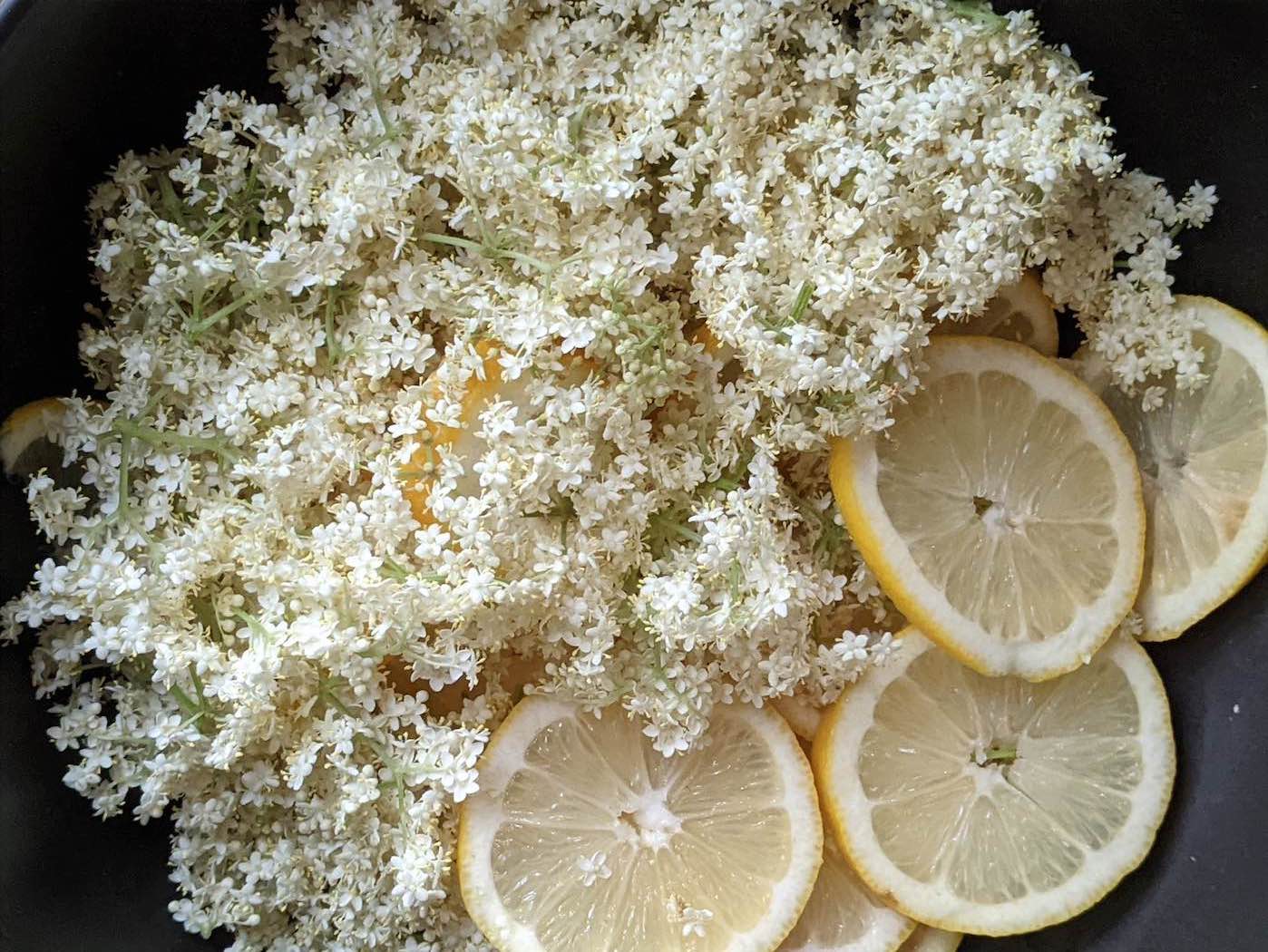If you know any plant from this family, it is likely to be elderberries. Elderberries have grown in popularity in recent years as health supplements to treat and prevent colds and other ailments. Although most of the 150-200 species of this family are elders and viburnums, it is sometimes called the moschatel family after its namesake, the moschatel plant (A. moschatellina).
Moschatel grows throughout much of the northern hemisphere in shady, damp boreal regions. The four-sided spring flowers give rise to some of its other common names: five-faced bishop, townhall clock, and Good Friday plant. The word moschatel itself echoes the musk-like scent the plant emits towards evening as dew falls.

The majority of this family, however, consists of elders and viburnums. These are known for their bright (especially in fall) colors, fragrant flowers, rich-colored fruits favored by birds, and wide cultural and medicinal uses.


Elders (Sambucus genus) are named after the Greek sambuce, an ancient wind instrument. The twigs can be modified to make whistles, and hollowed twigs have also been used to tap maple trees for syrup. Indigenous people of North America made blue elderberry wood into flutes, clappers, and whistles as well as pipes. The elders are especially known for their edible and medicinal berries. The viburnums have mostly inedible berries, at least among humans; however, they have beautiful foliage and are a popular food source for birds.
Fall foliage, fragrant flowers, and colorful berries attractive to wildlife
Elder plants grow across all continents except Antarctica and in both temperate and subtropical environments. They are widely cultivated as wildlife- and pollinator-attracting ornamentals and for their flowers and fruit. Some species are planted purposely as hedges or windbreakers.
Their species span the rainbow: red, black, blue, yellow, white, and dwarf elderberry as well as Chinese elder. The yellow (S. australasica) and white (S. gaudichaudiana) elderberries grow exclusively in Australia in or near rainforests. North American elders include blue elderberry (S. cerulea or S. nigra subsp cerulea), American red elder (S. pubens), red elderberry (S. racemose), and common elderberry (S. canadensis).


Viburnums, meanwhile, are popular as garden ornamentals and landscape plants due to their showy flowers and berries, fragrance, and eye-catching red and purple autumn colors. One notable example is Korean spice viburnum (V. carlesii), renowned for its highly fragrant, spicy-scented spring flowers.

Elderberries and viburnums provide food for birds and some butterfly species. Wildlife consume nannyberry viburnum (V. lentago) fruit during the winter across the northern United States and southern Canada, and the mapleleaf viburnum (V. acerifolium) appeals to butterflies, bees, birds, and various mammals.

Deep-colored edible fruits and flowers
The cooked berries of most elder species are edible, but the uncooked berries are not. In fact, the uncooked berries and other plant parts produce poisonous cyanogenic glycosides. Consumed in sufficient quantities, the cooked berry juice can cause abdominal and gastric upset. Nonetheless, there are many traditional uses for the cooked berries for moderate consumption.


When people talk about elderberry, they usually mean common elderberry (S. canadensis), native across eastern North America, or black or European elderberry (S. nigra), more common in Europe. The flowers and berries have long been used in food, especially cordials, wine, jams, chutneys, ketchup, and more. The flowers can be cooked into fritters for a delectable treat or infused into a cordial, which is a lightly fermented syrup that is diluted before serving as a beverage. Elderberry soup is a traditional meal in Scandinavia and Germany. Flowers and berries are used in elderberry wine as well as in other regional alcoholic specialties (e.g., St. Germain, brandy in Hungary, snaps in Sweden, jenever in Belgium, etc.).



Most viburnum berries, meanwhile, are mildly poisonous to humans. A few exceptions can be eaten raw or made into jam. Appalachian tea (V. cassinoides) leaves are used as a tea substitute and supposedly have a pleasant taste; the sweet fruits can be eaten raw or cooked. Nannyberry (V. lentago) fruits are also edible and can be made into a sauce, and the berries of mapleleaf viburnum (V. acerifolium) can be made into jam.


Circumboreal viburnums native to Canada and the northern U.S. include the highbush cranberry (V. edule), cranberrybush viburnum (V. trilobum), and guelder rose (V. opulus). Despite their names, neither the highbush cranberry or cranberrybush viburnum are true cranberries. Their red fruits merely resemble cranberries in both appearance and taste and ripen at the same time of year as true cranberries. They can be eaten either raw or cooked into jam, jelly, liqueur, and more.
In Central and South America, Sambucus peruviana produces fruit that is made into jams, wines, and other beverages. The wood is also used for construction, tools, and in the making of the Andean flute instrument, quena.

Traditional medicine
The berries, seeds, leaves, and flowers of the elders have many traditional uses, mainly as extracts. Elderberries are high in Vitamin C, underlying their popularity in immune-boosting treatments for flu, colds, and so on. Common preparations include teas, syrups, tinctures, extracts, or capsules.
The folklore surrounding elder is vast, with many tales suggesting its magical abilities in warding off evil. Indigenous people of North America have used blue elderberry (S. cerulea or S. nigra subsp cerulea) and red elderberry (S. racemose) medicinally and for food. The long usage of black or European elderberry (S. nigra) in traditional medicine by indigenous people and herbalists has paved the way for its modern-day popularity in dietary supplements. Very few scientific studies have confirmed their effectiveness in this area.

The bark and leaves of some viburnum species are also used in traditional medicine. For example, the leaves, berries, and stems of Linden arrowwood (V. dilatatum) are used in Chinese medicine. The bark of guelder rose (V. opulus), known more popularly as cramp bark, is said to help with menstrual and pregnancy pain.

Deep, vibrant colors and culture: Dye and cultural significance
Elderberries are rich in anthocyanins. Juice made from the berries has a deep purple-red color, giving rise to their use as a natural food colorant or fiber dye. The leaves and inner bark of common elderberry (S. canadensis) can be used as a dye and insecticide as well.
Chuque (V. triphyllum) grows in South American Andean forests where it plays an ecologically important role in partnering with fungi to fix nitrogen in nutrient-poor soils. The wood is used as fuelwood and in constructions, the bark tannins in tanneries, and the fruit as dye. Several other related species in South America are endangered.

Viburnums are culturally significant in Russia and Ukraine. Guelder rose or cranberry viburnum (V. opulus) has strong cultural significance in Russia (where it is called kalina) and Ukraine (kalyna). In Ukraine, it is a national symbol and features in art, poetry, and legend; it is associated with Koliada—e.g. winter festival or Christmastime—and in both countries is associated with the love of young women.




